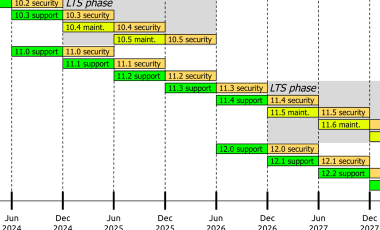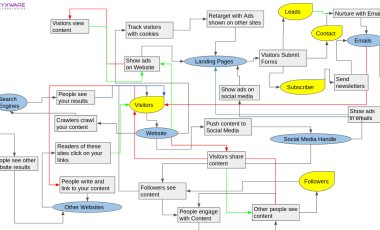Everything You Need to Know About Drupal Custom Theme Development
Introduction
Drupal is one of the most popular digital experience used by businesses for creating highly personalized, customer-focused websites. In fact, in 2022, over 1.7 million 1 websites have been powered by Drupal.
Creating a user experience (UX) fine-tuned for your target audience is the first step in the process when you plan to build/revamp your website. A website aims to deliver superior customer experiences and journeys that help your business drive customer loyalty and provide better service delivery.

With that in mind, Drupal’s theming engine is capable of converting any kind of user experience design to the final HTML output that visitors access when they navigate through the website.
Suppose your business needs to create a website that aligns with specific goals. In that case, you can leverage this digital experience platform’s functionality to customize your website or use an existing theme.
Let’s understand how you can customize a theme on the Drupal platform that resonates with the needs of your business. By the end of this blog, you will be able to determine whether you should use an off-the-shelf theme or customize one for specific requirements.
Drupal Theming Options
You can theme your website in four distinct ways on Drupal
1. Using Default Themes
If you are looking for a quick time-to-market and don’t wish to be bothered with too many or branding, you can launch your website quickly with a default Drupal theme Olivero.
Olivero is the default theme that comes with Drupal 9 and Drupal 10. It is 100% accessible, mobile friendly and is a lite theme that can be used to quickly create websites using Drupal. We have chosen to go with Olivero for the website we launched recently about Drupal 7 end of life.
2. Contributed Themes
The second option is contributed themes which can be downloaded freely from www.drupal.org. There are more than 200 themes (with a stable release for Drupal 9) to choose from.
Certain themes (like Barrio or Adaptive) come with many flexibilities, but many of them just cover the default templates, i.e. Page and node. If you plan to deploy an eCommerce store or a content-heavy website like a news portal, these might not be required.
3. Third-Party Paid Themes
The third option is to use third-party themes purchased from platforms like Themeforest, Envato, and TemplateMonster
You will need to pay for themes on these websites, which will be customizable for the most part. You can add brand colors and fonts to the package. These themes usually come with a lot of flexibility and different template options (occasionally including full example websites) to choose from.
4. Drupal Custom Theme Development
The fourth option is to develop your own theme for Drupal. This option is suitable for creating an immersive brand experience for your customers. Think of the website of Tesla - https://www.tesla.com/ which implement a custom theme for Drupal 9 which offer a unique brand experience.
3 Simple Steps for Drupal Custom Theme Development
To develop your custom Drupal theme, you must adopt a step-by-step approach, including working with specific theme files and library folders.
Drupal, thankfully, has made it simple enough not to require rocket scientists on board. Let’s understand the steps associated with Drupal custom theme development.
1. Start with UX Design
Any well-designed website features a user experience that is seamless and neat. The flow is intuitive, and all the necessary interactions a user needs are easily accessible.
Creating a good UX and UI design are the preliminary steps for custom themes.
2. Select a Base Theme
After a UX design is ready, the first step of theme customization begins.
Select a base theme for your website. The base theme for the frontend of your design depends on the underlying HTML/CSS framework you choose.
Olivero, Barrio, and Bootstrap are a few base themes you can begin with. A base theme makes the theme development process easier as it will include most templates that need to be overridden in your custom theme. Also it will come with a html/css framework. The new starterkit approach can also be used if that will best fit for your need.
3. Customize Your Theme
In the third step, you will customize your theme.
Just like your core theme has its folder in the Drupal installation, you need to create a folder for your custom theme similarly. This folder will contain information like the name, description, and type of your custom theme through a .yml file.
You can now conveniently use the HTML/CSS framework and its capabilities to design the front-end of your website.
It’s also important to note that Drupal 9 uses twig as its theming engine, which makes Drupal 9 themes more secure. By default, it is not possible to inject PHP code in twig templates.
Base themes come with tools that help you create sub-themes; alternatively, you can use the starter-kit model that is introduced in Drupal 9. You can leverage the Starterkit theme as a basis to create new independent themes instead of using extensions over the runtime like the Classy core theme.
Choosing between Custom Drupal Theme Development and Off-the-Shelf Themes
Selecting an off-the-shelf theme or customizing one depends on the kind of business and its requirements.
When to Use Off-the-Shelf Themes?
- Businesses that need their website to be live on the market abruptly or on a tight timeline should opt to use off-the-shelf themes.
- If your business is starting and is mindfully allocating its resources, you should use off-the-shelf themes. In simpler words, off-the-shelf themes are cost-effective for younger firms.
- Off-the-shelf themes work like a charm for specific marketing campaigns like creating seasonal offer landing pages.
When to Go for Drupal Custom Theme Development?
- Custom themes work best for mature businesses looking to offer customers a thoroughly customized brand experience.
- Suppose your business is taking the next leap into growth and has amassed staying power in the market. In that case, you can opt for creating a more customized website for enhancing customer journeys, aiming at business growth.
- If you have a business ready to provide better functionality to its users, create a unique custom theme fine tuned for the target audience and user journeys may be the best option instead of depending on an out of the box free or paid theme.
Long Story Short
It isn’t difficult to create a custom theme in Drupal. However, depending on the level of in-house expertise, the time you dedicate to this activity may vary.
It is prudent to use off-the-shelf themes if your business cannot dedicate the resources needed for theme customizations Or you want to build a prototype quickly.
On the other hand, a custom Drupal theme with a unique user experience and brand identity is better suited for mature businesses looking to achieve high-quality user touchpoints online.
FAQ
While Drupal 7 runs on the PHPTemplate as its default theme engine, Drupal 9 uses Twig (which replaces the PHPTemplate as the default theme engine).
The Drupal Starterkit theme is a command line tool that allows developers to start a new theme from scratch or from a template. On the other hand, in Drupal base themes, the sub-theme extends the base theme, and the base theme is used in runtime as part of your theme.
This is a needs-based decision. You can use the Micro theme module on Drupal to create microsites on Drupal for the specific needs of your industry, as micro websites for a product or specific project may need to incorporate the brand elements of the parent website.
No, it is not possible to use a Drupal 7 theme in Drupal 9 or Drupal 10 websites. Drupal 7 uses PHPtemplate as the theme engine, whereas the latest versions of Drupal use twig theme engine. As Drupal themes uses HTML and CSS, it is possible to extract the HTML/CSS components from the Drupal 7 theme and reuse them in the Drupal 9 themes or Drupal 10 themes.
Technically it is possible to use a theme created for Drupal 8 in Drupal 9 with minor changes. If there are lots of customizations, specifically theme preprocess functions, a Drupal 9 compatibility check needs to be done to enable the code to support Drupal 9 before using it there.
Yes, it is possible to maintain a Drupal 9 theme compatible with Drupal 10 by replacing all the functions that are deprecated in Drupal 10. If the developer closely follow the Drupal 10 releases, it will be easy to maintain a theme that is supported by Drupal 9 as well as Drupal 10 and when Drupal 10 get released, the theme can be used in a Drupal 10 website without any change.
Yes, Drupal will support component-based theming that will enable atomic design with the help of the Patternlab development environment through Twig.
An off-the-shelf theme is used when you need to get a website up and running quickly or want to show a proof of concept or prototype, or if the budget is really low. If you are looking to build a digital experience platform that should stand for the long term and support all the customer journeys you define and be unique to your brand, the best option is to go with the custom theme development.



